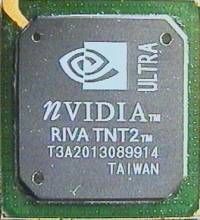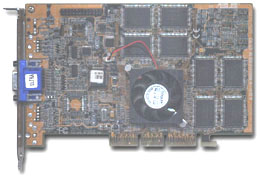Riva TNT2 Ultra

How can you explain the introduction of TNT 2 Ultra to the market? The fact that there are such people to whom no matter how much you give, everything will not be enough. These people have 21" monitors, they like to play at 1900x1200x32 resolutions. They turn all the settings on full. And they have a lot of money.
The last argument had the best effect on nVidia. And indeed. The chip manufacturing process is so well-adjusted that most Riva TNT2s have such an undocumented feature as overclocking. Moreover, if TNT was overclocked by 20 MHz, then TNT2 is overclocked by 50-60 MHz. So why not make these frequencies official in new chips, for which specimens will be selected from thousands of others?
Really. All you need to do is to reach higher frequencies. The 0.25 µm technology makes this possible. The selected one of the many chips is labeled as Ultra, placed on the same printed circuit board as the regular one. An increased frequency is applied to it, a more powerful cooler is installed. The card is equipped with faster video memory. The new video card is sold labeled "Ultra".
The only difference between Riva TNT2 Ultra and Riva TNT2 is higher frequencies. And if Riva TNT2 operates at nominal 125/150 MHz, then Riva TNT2 Ultra operates at 150/183 MHz. Accordingly, the memory bandwidth is increased to 2.9 Gb/sec. It is worth adding here that on different TNT2 Ultra boards, the frequencies could vary, depending on the quality of the cooling and the memory used.
Since the manufacturing process of Riva TNT2 Ultra and Riva TNT2 is the same, the first chip got hotter. Therefore, cards based on it were supplied with powerful coolers. However, Riva TNT2 Ultra was overclocked to 190/230 MHz. The fill rate is 380 MTexels/sec. The maximum processing speed is over 8.5 MPolys/sec. Due to this, Riva TNT2 Ultra outperformed many OpenGL accelerators in professional applications. Graphic stations were assembled and sold on Riva TNT2 Ultra.
| Name | Riva TNT 2 |
| Core | NV5 |
| Process technology (µm) | 0.25 |
| Transistors (million) | 10.5~15 |
| Core frequency | 125 |
| Memory frequency (DDR) | 150 |
| Bus and memory type | SDR-128bit |
| Bandwidth (Gb/s) | 2.4 |
| Pixel pipelines | 2 |
| TMU per conveyor | 1 |
| textures per clock | 2 |
| textures per pass | ? |
| Vertex conveyors | No |
| Pixel Shaders | No |
| Vertex Shaders | No |
| Fill Rate (Mpix/s) | 250 |
| Fill Rate (Mtex/s) | 250 |
| DirectX | 6.0 |
| Anti-Aliasing (Max) | No (?) |
| Anisotropic Filtering (Max) | No (?) |
| Memory | 32MB |
| Interface | AGP4x |
| RAMDAC | 300MHz |
That's all the differences from Riva TNT2. Riva TNT2 Ultra drivers were identical to all TNT products. The quality is the same as Riva TNT2.

Riva TNT2 Ultra represented the market for expensive high-end 2D/3D graphics cards.



